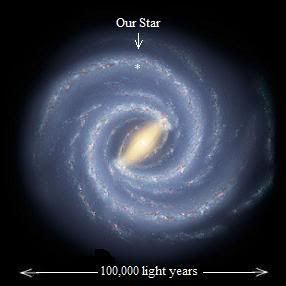Post by glactus on May 9, 2009 2:08:41 GMT

Our star and the Milky Way
Our galaxy is a giant cartwheel, turning, and our star and its planets (our solar system) are out on a spiral arm about three quarters the distance from the center of the galaxy.
From where we are, and with the turning of the cartwheel, our Solar System is speeding round the galaxy at half a million miles per hour.
Even at that speed, the galaxy is so big that one revolution takes 226 million years, and since we evolved almost 5 billion years ago, we've been round 19 times.
The Milky Way is one of the giants of the Universe, and to give you some idea of its size in space and time, consider the following:
If a young couple became married today and stepped into a space vehicle to honeymoon across the galaxy from one end to the other, and if they conceived a child in the first year, and taking into account that a generation on Earth is 30 years (our children's children) then, travelling at 669millin 600 thousand miles per hour (the speed of light), 3,766 such generations would take place with life and death, before some-one got there.
We have proof that there is one intelligent civilization in our galaxy, and because we now believe that there are hundreds of billions of planets orbiting other stars entwined in its gigantic structure, there is speculation that even at a billion to one chance of there being another civilization, there would be hundreds of thousands of them embedded in the Milky Way galaxy.
Will we ever find them? In centuries hence - yes, they will come to us in the beam of light which they emit.
Advances in science and computers will show us the way, and decode the medium of light for us. Then we will be able to sit back and view any beam of light that takes our fancy, anywhere, and marvel at the landscapes we see, features, languages, cultures and technologies that may be more advanced than our own.
Thus is our destiny, and our place in space and time as we traverse the Milky Way galaxy.
Credits: The Milky Way galaxy image:
This is artwork by David Darling from the encyclopedia of science
www.daviddarling.info/images/Milky_Way_Galaxy_artwork.jpg


